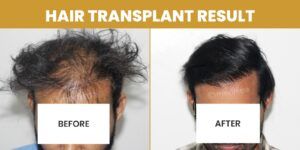
Crown area of the scalp also referred to as vertex is the top of the head and in many cases a centre-point of male pattern baldness. What starts often with a single bald patch that starts to spread out from the crown and eventually meets with a receding hairline leading to complete baldness on the head other than some pack of hair on the back and sides of the head. Obviously hair loss from this area is embarrassing and can lead to self esteem issues. There may be psychological disturbance and anxiety issues due to this professional and social embarrassment.
What leads to hair loss?
Hair loss can be temporary or permanent. Male or female pattern baldness referred to as androgenic alopecia is a genetic dysfunction where hair follicles grow sensitive to androgenic hormones and then begin to shrink and eventually hair loss happens. The common contributing factors causing hair loss sometimes happen with improper use of hair care products such as hair straightener, curler, chemicals or sometimes due to lifestyle leading to stress, tight braiding, post menopausal hormonal change or even some medications (anti depressants, anti anxiety and anti psychotics), increased pollution and poor nutrition. Other causes of hair loss could be due to some diseases or associated treatments.
Pattern of hair loss in Male pattern baldness
Male pattern baldness involves mainly the hair from the frontal region and vertex region. The hair from above the temples begins to thin and hair loss stars giving the impression that hairline is receding. Hair follicles from back and side of the head are DHT or androgen resistant and thus do not shrink under the influence of androgens. Hence, these DHT resistant hair follicles when transferred to bald area of scalp do not undergo changes under influence of androgens.
Stages of Hair Loss in Men
Norwood classification signifies the extent of male pattern baldness based on its seven stages.
The stages are as follows:
Class I: Complete hairline lies high on the forehead which is not actually balding.
Class II: Triangular areas of recession in the temple area and minimal recession on mid frontal area.
Class III: Borderline case. Deepening of temporal triangular recession or includes hair loss at the vertex.
Class IV: Further frontal hair loss and extension of hair loss from vertex but still a wide band of hair present separating frontal and vertex hair loss.
Class V: Further extension of frontal and vertex hair loss and breaking of separation line of hairs between frontal and vertex baldness.
Class VI: Disappearance of band of hair between frontal and vertex baldness.
Class VII: Extensive bald area present only in occipital area (back and side of the head)
How it is treated?
Temporary Solutions such as wigs or prosthetic hair are used often to cover up the bald areas on the head but the hassles associate with maintenance and replacement plus poor aesthetics are a huge let own.
Medications:
Minoxidil (Rogaine): This is an over the counter lotion based formulation which is applied topically and aims at reducing the hair loss. It improves the blood flow and thus, hair growth rate is enhanced.
Finasteride: It is a prescribed orally administered medication intended to decrease the amount of DHT hormone which in turn could lead to slower the progression of hair loss and increase the rate of hair growth.
The only problem with the above medications is that once they are stopped, the hair loss returns and obviously one cannot take medicines perpetually.
Thus, there is always a quest to find the best treatment for dealing with hair loss on crown area of scalp.
Hair transplant cosmetic procedure:
Is the only permanent solution to deal with hair loss from genetic or natural reasons. Hair transplant is a minimally invasive surgical procedure where as explained above permanent hair roots from DHT resistant areas are transplanted to the target bald site. It is performed by 2 primary methods: FUT and FUE which are differ on the basis of graft harvesting technique. The choice of these techniques is based upon the number of follicles required to cover the bald area. In cases of extensive hair loss combination technique of FUT +FUE is performed which could successfully retrieve more than 4000 hair grafts.
It is the only effective solution to deal with hair loss on the crown area of the scalp because it provides purely natural results and also thanks to hairline design procedure, the outcome look extremely aesthetic and not like a wig. As a result, Hair transplant in India has become a treatment of choice when it comes to dealing with hair loss. However, only important thing is the choice of surgeon and clinic. Dr Suneet Soni (MCh Plastic surgeon), owner of Medispa hair transplant clinic in Delhi and Jaipur is a globally revered surgeon who has performed all major techniques in hair transplants and successfully delivered exemplary results in his 5000+ cases. His artistic bent of mind and precision enable him to design a classic hairline that is almost impossible to distinguish from the real hairline.







